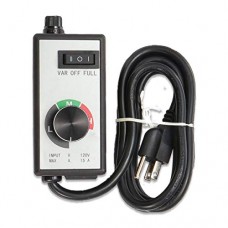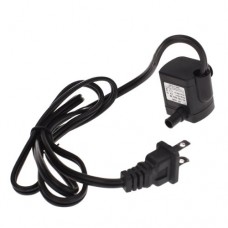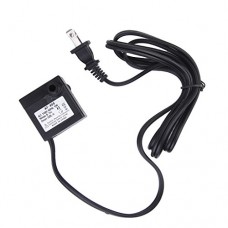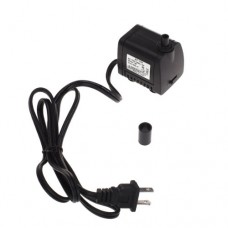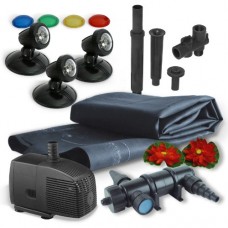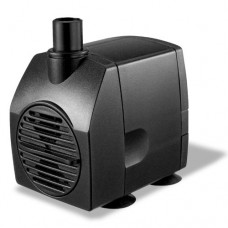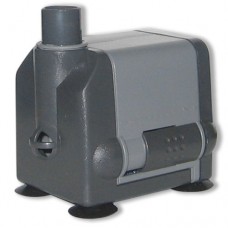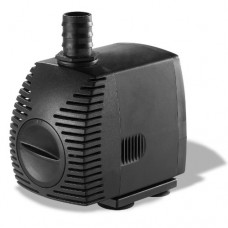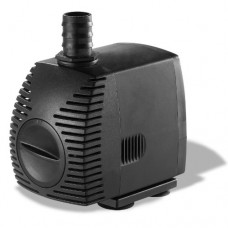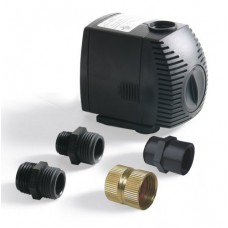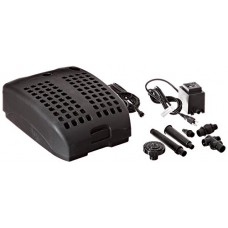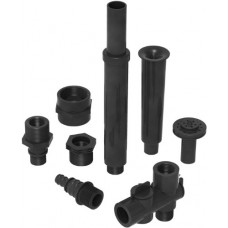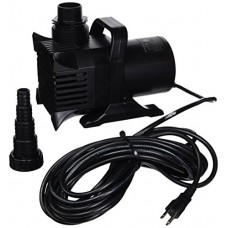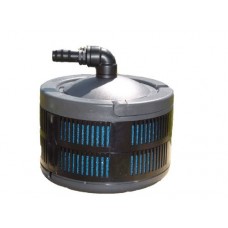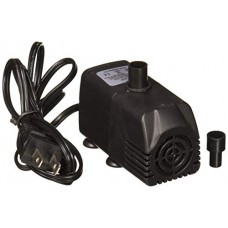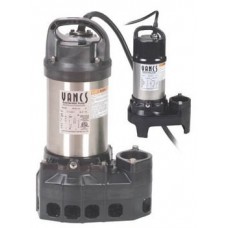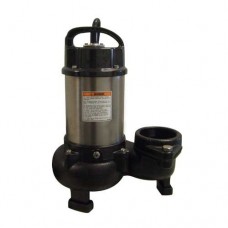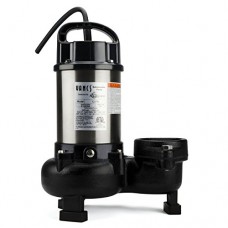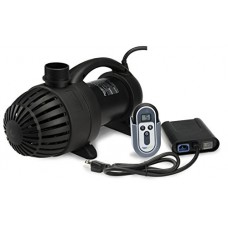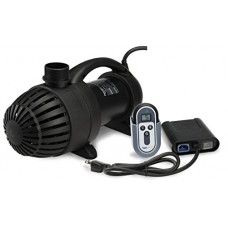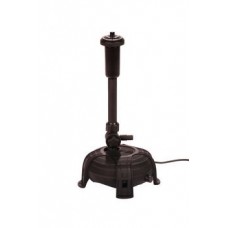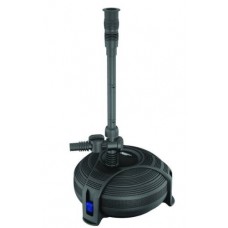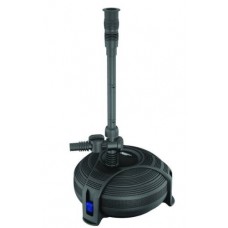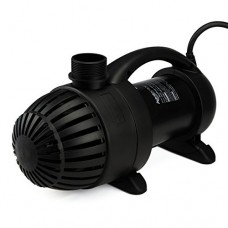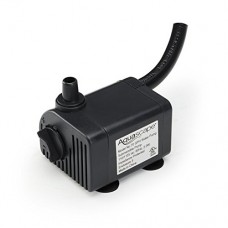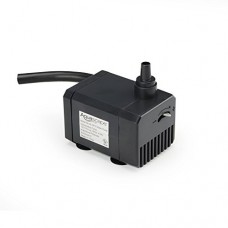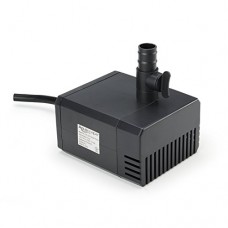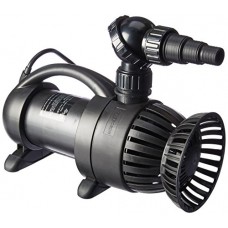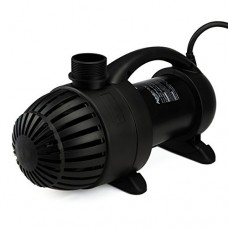Pumps By Flow
A good rule of thumb for small ponds is to turn over the full volume of the pond water twice every hour to ensure proper circulation and help buffer water temperature fluctuations. Your filtration system, waterfall height, hose lengths and diameters and plumbing components that are to make everything operate properly will consume a portion of the pump's overall flow. The rated flow of a pump is often with no restriction and shows the gallons per hour or liters per hour of the water as it comes right out of the pump. Any given tubing system, plumbing fitting elbows or tees, filters or opening that water moves through or around creates a drag. Frictional loss measures the amount of water flow rate lost to drag. Static head refers to the distance between the pond water surface and the highest point to which the water is lifted. These two factors added together create the total dynamic head and the final tally of total dynamic head that you measure directs you to select a pump often with with a flow rate greater than you might presume. You can restrict an excess flow, if desired, but you cannot make a pump deliver a higher flow rate than its capacity.
Refine Search
15 Amp Variable Speed Control For Koi Pond & Waterfall Pumps
Variable Speed Controller for Koi Ponds, Water Gardens and W..
AC 110V 3W 44GPH Submersible Water Pump Aquarium Fountain Pond Pump US Plug
Flow adjustable water pump is designed fully submersible for..
AC 110V 5W Submersible Water Pump Aquarium Pond Fountain Pump US Plug
Flow adjustable water pump is designed fully submersible for..
AC 110V 7W Submersible Water Pump Aquarium Fountain Pond Pump US Plug
Flow adjustable water pump is designed fully submersible fo..
Algreen Products 1, 200 Gallon Pond Kit with Lighting System
Algreen has been dedicated to basic principles, which has he..
Algreen Products 130Gph Statuary Fountain Pump for Water Features
Algreen has been dedicated to basic principles, which has he..
Algreen Products 158Gph Statuary Fountain Pump
Statuary fountain pumps 306 gallons per hour with flow contr..
Algreen Products 320Gph Statuary Fountain Pump for Water Features
Algreen has been dedicated to basic principles, which has he..
Algreen Products 500Gph Pond Pump for Gardening and Water Features
Algreen has been dedicated to basic principles, which has he..
Algreen Products 500GPH Rain Barrel Pump Kit
Water your garden with less hassle thanks to the Algreen Rai..
Algreen Products All-in-One Crystal Flow Pump with Pond Filtration and UV Clarifier - 21001
Algreen has been dedicated to basic principles, which has he..
Algreen Products Fountain Nozzle Component Kit for Statuary Fountain Pumps and Pond Pumps, 3/4-Inch and 1/2-Inch
Algreen has been dedicated to basic principles, which has he..
Algreen Products MaxFlo 20000 to 5500 GPH Pond and Waterfall Pump for Gardening
Algreen has been dedicated to basic principles, which has he..
Algreen Products SuperFlo Pump Filters Include Both Mechanical and Biological Filtration for Ponds and Gardening
13 Watt UV Clarifier Benefits Fish and Plants by Reducing Al..
Anjon 550 gph Monsoon Pond Pump - submersible energy efficient motor
This energy efficient 550 gph pond pump is oil free and can ..
Aquascape 29495 Tsurumi 8PN Submersible Pump for Ponds, Skimmer Filters, and Pondless Waterfalls
Tsurumi PN Series Pumps Tsurumi Submersible Pumps for Profes..
Aquascape 30391 Tsurumi 12PN Submersible Pump for Ponds, Skimmer Filters, and Pondless Waterfalls, 10,000 GPH
Tsurumi 12PN 1 H.P. 1/115V, submersible pond pump with a 3" ..
Aquascape 30391 Tsurumi 12pn Submersible Pump For Ponds, Skimmer Filters, And Pondless Waterfalls, 10,000 Gph
Ideal for use in skimmer filters and pondless waterfall appl..
Aquascape 45009 2000-4000 Asynchronous Pump for Ponds, Pondless Waterfalls & Skimmer Filters, 3947 GPH, Black
Just like the 3 bears, you don't want your pond less waterfa..
Aquascape 45010 4000-8000 Asynchronous Pump for Ponds, Pondless Waterfalls & Skimmer Filters, 7793 GPH, Black
AquascapePRO AquaSurge PRO 4000-8000 Pumps 45010 Extremely e..
Aquascape 91014 AquaJet 600 Submersible Pump for Ponds, Fountains, Waterfalls, and Filters, 525 GPH
AquaJet Pond Pumps 600 gph: The new AquaJet all-in-one foun..
Aquascape 91015 AquaJet 1300 Submersible Pump for Ponds, Fountains, Waterfalls, and Filters, 1,350 GPH
AquaJet 1300 Pump Submersible fountain, waterfall and filter..
Aquascape 91016 AquaJet 2000 Submersible Pump for Ponds, Fountains, Waterfalls, and Filters, 2,000 GPH
AquaJet 2000 Pump Submersible fountain, waterfall and filter..
Aquascape 91020 5000 Asynchronous Pump for Ponds, Pondless Waterfalls & Skimmer Filters, 5284 GPH
Reduce your energy costs and reduce the noise produced by yo..
Aquascape 91023 70 GPH Statuary and Fountain Pump, 2.1-Feet, Black
Submersible fountain, waterfall and filter pump.Aquascape St..
Aquascape 91024 90 GPH Statuary and Fountain Pump, 2.8-Feet, Black
Submersible fountain, waterfall and filter pump.Aquascape St..
Aquascape 91026 320 GPH Statuary and Fountain Pump, 5.6-Feet, Black
Submersible fountain, waterfall and filter pump.Aquascape St..
Aquascape AQSC 3196GPH Aqua Surge Pump
Aquascape AquaSurge 3000 Pump Pumps 91018 AquaSurge second-g..
Aquascape AquaSurge 4000 Asynchronous Pump for Ponds, Pondless Waterfalls, and Skimmer Filters, 3,947 GPH | 91019
Submersible waterfall and filter pump made for use in skimme..
AquaSurge 5000 Skimmer & Pondless Waterfall Vault Pumps by Aquascape - 2012 2nd Generation
AquaSurge® second-generation asynchronous skimmer and waterf..

